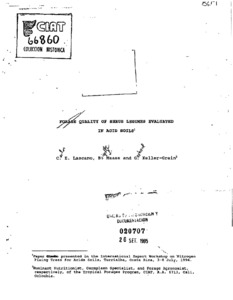Forage quality of shrub legumes evaluated in acid soils
The forage quality of shrub legume species planted in acid soils of the llanos and forest margins of Colombia was evaluated by the Tropical Forages Program (TFP) of CIAT. Results showed differences in quality among and within species. Species free of tannins such as Cratylia argentea and Desmodium velutinum had medium in vitro dry matter digestibility (IVDMD) and high crude protein (CP). In contrast, species with tannins such as Flemingia macrophylla, Tadehagi spp., Dendrolobium spp. and Codariocalyx gyroides had adequate CP but low IVDMD. In these legumes, IVDMD of different accessions within species was negatively correlated with level of extractable condensed tannins (ECT). However, only 20 to 30 percent and 40 to 70 percent of the variation in IVDMD could be explained by level of ECT in the wet and dry seasons, respectively. The capacity of ECT to complex protein was variable among shrub legumes, and was related to degree of polymerization of CT. Extractable CT and protein-bound CT were negatively correlated (r=-0.5) with IVDMD, but no relationship was found between fiber-hound CT and IVDMD. Of the species evaluated, C. argentea and D. velutinum have high potential as fodder for livestock. Other species evaluated appear to have low feeding value due to the presence of CT and not well defined phenols and cell wall constituents which could also affect digestibility. Future studies should investigate factors responsible for low digestibility of some nitrogen fixing shrub legumes and determine the effects of level, structure and form of condensed tannins on ruminant nutrition.

